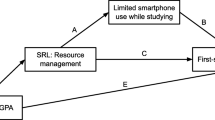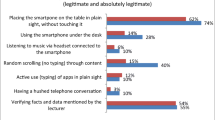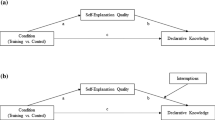Abstract
Smartphone use in learning environments can be productive or distracting depending upon the type of use. The use is also impacted by the learner’s view and understanding of the smartphone and self-regulated learning skills. Measures are needed to specify uses and learner understandings to address the implications for teaching and learning. This study reports on the development of a multi-factor inventory designed to measure multitasking while studying, avoiding distractions while studying, mindful phone use, and phone knowledge. The inventory was completed by 514 undergraduate students enrolled in a first-year seminar. The results indicate good reliability and a three-factor structure with multitasking and avoiding distraction merging into one factor. The resulting measure can support research to improve self-regulation of smartphone use. Suggestions regarding instructional use are provided.

Similar content being viewed by others
Explore related subjects
Discover the latest articles, news and stories from top researchers in related subjects.References
Alter, A. L. (2017). Irresistible: The rise of addictive technology and the business of keeping us hooked (EBSCOhost, Ed.). New York : Penguin Press.
Anderson, M. (2018). A Majority of Teens Have Experienced Some Form of Cyberbullying (Pew Research Center Internet & Technology). https://www.pewresearch.org/internet/wp-content/uploads/sites/9/2018/09/PI_2018.09.27_teens-and-cyberbullying_FINAL.pdf
Anderson, M., & Jiang, J. (2018). Teens, Social Media & Technology 2018 (may; pp. 1–19). Pew research center. https://www.pewresearch.org
Anderson, M., & Smith, A. (2018). Social Media Use in 2018. Pew Research Center. https://www.pewresearch.org, http://assets.pewresearch.org/wp-content/uploads/sites/14/2018/03/01105133/PI_2018.03.01_Social-Media_FINAL.pdf
Anshari, M., Almunawar, M. N., Shahrill, M., Wicaksono, D. K., & Huda, M. (2017). Smartphones usage in the classrooms: Learning aid or interference? Education and Information Technologies, 22(6), 3063–3079. https://doi.org/10.1007/s10639-017-9572-7.
Ariel, Y., & Elishar-Malka, V. (2019). Learning in the smartphone era: Viewpoints and perceptions on both sides of the lectern. Education and Information Technologies, 24(4), 2329–2340. https://doi.org/10.1007/s10639-019-09871-w.
Bellhäuser, H., Lösch, T., Winter, C., & Schmitz, B. (2016). Applying a web-based training to foster self-regulated learning—Effects of an intervention for large numbers of participants. The Internet and Higher Education, 31, 87–100. https://doi.org/10.1016/J.IHEDUC.2016.07.002.
Bernacki, M. L., Vosicka, L., & Utz, J. C. (2019). Can a brief, digital skill training intervention help undergraduates “learn to learn” and improve their STEM achievement? Journal of Educational Psychology. https://doi.org/10.1037/edu0000405.
Britton, B. K., & Tesser, A. (1991). Effects of time-management practices on college grades. Journal of Educational Psychology, 83(3), 405–410. https://doi.org/10.1037/0022-0663.83.3.405.
Donovan, L., Green, T., & Hartley, K. (2010). An examination of one-to-one computing in the middle school: Does increased access bring about increased student engagement? Journal of Educational Computing Research, 42(4), 423-441.
Elhai, J. D., & Contractor, A. A. (2018). Examining latent classes of smartphone users: Relations with psychopathology and problematic smartphone use. Computers in Human Behavior, 82, 159–166. https://doi.org/10.1016/J.CHB.2018.01.010.
Felisoni, D. D., & Godoi, A. S. (2018). Cell phone usage and academic performance: An experiment. Computers & Education, 117, 175–187. https://doi.org/10.1016/J.COMPEDU.2017.10.006.
Gazzaley, A., & Rosen, L. D. (2016). The distracted mind: Ancient brains in a high-tech world. MIT Press.
Gorman, T. E., & Green, C. S. (2016). Short-term mindfulness intervention reduces the negative attentional effects associated with heavy media multitasking. Scientific Reports, 6(1), 24542. https://doi.org/10.1038/srep24542.
Hartley, K., Bendixen, L. D., Shreve, E., Gianoutsos, D., & Olafson, L (2020, April). Smartphone use and the self-regulated learner: Relationships between type of use and metacognitive factors. Paper accepted (meeting cancelled) for presentation at the annual meeting of the American Educational Research Association, San Francisco, CA.
Kirschner, P. A., & De Bruyckere, P. (2017). The myths of the digital native and the multitasker. Teaching and Teacher Education, 67, 135–142. https://doi.org/10.1016/J.TATE.2017.06.001.
Lepp, A., Barkley, J. E., & Karpinski, A. C. (2015). The relationship between cell phone use and academic performance in a sample of U.S. college students. SAGE Open, 5(1). https://doi.org/10.1177/2158244015573169.
Nayak, J. K. (2018). Relationship among smartphone usage, addiction, academic performance and the moderating role of gender: A study of higher education students in India. Computers & Education, 123, 164–173. https://doi.org/10.1016/J.COMPEDU.2018.05.007.
Pintrich, P. R., & De Groot, E. V. (1990). Motivational and self-regulated learning components of classroom academic performance. Journal of Educational Psychology, 82(1), 33–40.
Pintrich, P. R., Smith, D., Garcia, T., & Mckeachie, W. J. (1991). Motivated strategies for learning questionnaire manual (pp. 1–79). https://doi.org/10.13140/RG.2.1.2547.6968
R Core Team. (2018). R: A Language and environment for statistical computing. https://cran.r-project.org/
Rosen, L. D., Carrier, L. M., & Cheever, N. A. (2013). Facebook and texting made me do it: Media-induced task-switching while studying. Computers in Human Behavior, 29(3), 948–958. https://doi.org/10.1016/J.CHB.2012.12.001.
Rosseel, Y., & Jorgensen, T. D. (2018). lavaan: Latent Variable Analysis. https://cran.r-project.org/package=lavaan.
Schneider, M., & Preckel, F. (2017). Variables associated with achievement in higher education: A systematic review of meta-analyses. Psychological Bulletin, 143(6), 565–600. https://doi.org/10.1037/bul0000098.
Schraw, G., & Dennison, R. S. (1994). Assessing metacognitive awareness. Contemporary Educational Psychology, 19(4), 460–475.
Schunk, D. H., & Greene, J. A. (2018). Handbook of self-regulation of learning and performance. Routledge.
Soomro, K. A., Zai, S. A. Y., Nasrullah, & Hina, Q.A. (2019). Investigating the impact of university students’ smartphone addiction on their satisfaction with classroom connectedness. Education and Information Technologies, 24(6), 3523–3535. https://doi.org/10.1007/s10639-019-09947-7.
Tabachnick, B. G., & Fidell, L. S. (2013). Using multivariate statistics (6th ed.). Pearson.
Terry, C. A., Mishra, P., & Roseth, C. J. (2016). Preference for multitasking, technological dependency, student metacognition, & pervasive technology use: An experimental intervention. Computers in Human Behavior, 65, 241–251. https://doi.org/10.1016/j.chb.2016.08.009.
The Jamovi Project. (2019). Jamovi (Version 1.0) [Computer Software]. jamovi. https://www.jamovi.org/
Usher, E. L., & Schunk, D. H. (2018). Social cognitive theoretical perspective of self-regulation. In D. H. Schunk & J. A. Greene (Eds.), Handbook of self-regulation of learning and performance (2nd ed., pp. 35–51). Routledge. https://doi.org/10.4324/9781315697048.
Uzun, A. M., & Kilis, S. (2019). Does persistent involvement in media and technology lead to lower academic performance? Evaluating media and technology use in relation to multitasking, self-regulation and academic performance. Computers in Human Behavior, 90, 196–203. https://doi.org/10.1016/J.CHB.2018.08.045.
Yildirim, C., & Correia, A.-P. (2015). Exploring the dimensions of nomophobia: Development and validation of a self-reported questionnaire. Computers in Human Behavior, 49, 130–137. https://doi.org/10.1016/j.chb.2015.02.059.
Availability of data and material
All de-identified data and materials are available upon request.
Author information
Authors and Affiliations
Corresponding author
Ethics declarations
Conflict of interest
None.
Additional information
Publisher’s note
Springer Nature remains neutral with regard to jurisdictional claims in published maps and institutional affiliations.
Rights and permissions
About this article
Cite this article
Hartley, K., Bendixen, L.D., Olafson, L. et al. Development of the smartphone and learning inventory: Measuring self-regulated use. Educ Inf Technol 25, 4381–4395 (2020). https://doi.org/10.1007/s10639-020-10179-3
Received:
Accepted:
Published:
Issue Date:
DOI: https://doi.org/10.1007/s10639-020-10179-3




